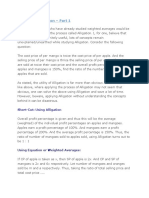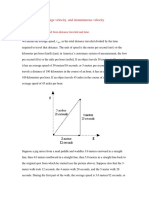Unit Rate Extra Practice & Explainations: Rate Rate Rate Rate Ratios Rate Rate Rate
Unit Rate Extra Practice & Explainations: Rate Rate Rate Rate Ratios Rate Rate Rate
Uploaded by
allenthomasonCopyright:
Available Formats
Unit Rate Extra Practice & Explainations: Rate Rate Rate Rate Ratios Rate Rate Rate
Unit Rate Extra Practice & Explainations: Rate Rate Rate Rate Ratios Rate Rate Rate
Uploaded by
allenthomasonOriginal Description:
Original Title
Copyright
Available Formats
Share this document
Did you find this document useful?
Is this content inappropriate?
Copyright:
Available Formats
Unit Rate Extra Practice & Explainations: Rate Rate Rate Rate Ratios Rate Rate Rate
Unit Rate Extra Practice & Explainations: Rate Rate Rate Rate Ratios Rate Rate Rate
Uploaded by
allenthomasonCopyright:
Available Formats
Unit Rate Extra Practice & Explainations
A rate is a form of ratio in which the two terms are in different units. For example price of wheat is $2 for 3 Kgs, then the rate would be $2 for 3 Kgs and the unit of rate would be $/Kg. Similarly if a car goes 100 miles in 1.5 hour, then the rate is 100 miles per 1.5 hour and unit is miles/hr. Note that ratios are usually unit less. Unit rate is a rate in which the rate is expressed as a quantity of 1. Simply put is rate which has denominator of 1. For example, if a car goes 60 miles in 1 hour, then the unit rate is 60 miles per hour. Other examples are $5 per Kg, 5 mt per second and $80 per barrel. Unit price is the rate when it is expressed in unit currency like dollar or cent. An example is price of corn is $2 per ounce and price of petrol is $5 per gallon. Remember that the price is always the numerator and the unit is the denominator.
Converting rate to unit rate/price Rate can be converted to unit rate simply by dividing the first term by second term. Consider an example: Q1. If a car travels 45 miles in 30 min, what is the rate at which the car is travelling? Solution: If we express the rate in miles/hr, the rate would simply be 45/0.5 miles per hr which is 90 miles per hr. If we want to express in minutes, then the rate would be 45/30 = 1.5 miles per minute. Q2. If John bought 2.5 Kgs of rice for $7.5, then what is the unit price of rice? Solution: Here the denominator should be 2.5 Kg and numerator is the price $7.5. The unit price of rice would thus be 7.5/2.5 = 3 $/Kg. Rates and unit rates are used to solve many real world problems. For example consider the problem: It takes 30 minutes for a tap to fill one bucket. How much time would it take to fill 6 buckets? The problem can be done using the concept of unit rate. The unit rate to fill the buckets would be 1/0.5 bucket per hour which is 2 buckets per hr. Thus to fill 6 buckets, it would take 6/2 = 3 hours. Such problems can also be solved easily using proportions. However, unit rates are still more convenient for comparison since they are already in simplified form and the denominator is 1.
Resource found at: http://www.algebra.com/algebra/homework/proportions/rat es.lesson
You might also like
- Corporate Finance - PresentationDocument14 pagesCorporate Finance - Presentationguruprasadkudva83% (6)
- Sunco QuestionDocument10 pagesSunco QuestionVarun HknzNo ratings yet
- Guide To Classic Chart PatternsDocument1 pageGuide To Classic Chart PatternsThato Mavuso100% (6)
- Grade 7Document14 pagesGrade 7Ray Allen FabroNo ratings yet
- Measuring Time and RateDocument15 pagesMeasuring Time and RateRei HozukiNo ratings yet
- Unit 1 Ratio, Proportion and PercentagesDocument22 pagesUnit 1 Ratio, Proportion and Percentagesluxolodabula1No ratings yet
- Math (3rd Year)Document15 pagesMath (3rd Year)Khawaja EshaNo ratings yet
- Std6 - Mathematics (Lecturesheet and Worksheet) - Chapter9.1Document5 pagesStd6 - Mathematics (Lecturesheet and Worksheet) - Chapter9.1pranabNo ratings yet
- Enigma of Alligation - Part 1: Short-Cut: Using AlligationDocument7 pagesEnigma of Alligation - Part 1: Short-Cut: Using AlligationAnonymous OBPVTEuQLNo ratings yet
- Identify Unit RatesDocument11 pagesIdentify Unit RatesAbhinav SinghNo ratings yet
- Math Short CutsDocument28 pagesMath Short Cutssalauddin84No ratings yet
- Math 110 Automotive Worksheet 3Document3 pagesMath 110 Automotive Worksheet 3nthethemabitle387No ratings yet
- ZzdimanalworksheetDocument3 pagesZzdimanalworksheetapi-233552637No ratings yet
- 3 Common Mistakes You Must Avoid in Distance QuestionsDocument14 pages3 Common Mistakes You Must Avoid in Distance Questionsabhishek pathakNo ratings yet
- Unit 5 Section 2Document6 pagesUnit 5 Section 2david.klapheckNo ratings yet
- Fundu'sDocument32 pagesFundu'sAnirban BanerjeeNo ratings yet
- Finding Unit Rate NotesDocument7 pagesFinding Unit Rate Notesapi-310102170No ratings yet
- Treatment MathDocument15 pagesTreatment MathLaurensius MarcellNo ratings yet
- Assignment 1.1 - Conversions - Dimensional AnalysisDocument4 pagesAssignment 1.1 - Conversions - Dimensional AnalysisBilly JenkinsNo ratings yet
- Practice Problems Using Conversion FactorsDocument1 pagePractice Problems Using Conversion FactorsCalvz John Serquiña AnteNo ratings yet
- 08 Convert Miles Per Hour To Feet Per SecondDocument5 pages08 Convert Miles Per Hour To Feet Per Secondsherilyn palacayNo ratings yet
- Quantz Tricks 1Document29 pagesQuantz Tricks 1CATMentor100% (2)
- TIME SPEED AND DISTANCE SHORTCUTS PDFAbout Time Speed and Distance Shortcuts PDFDocument3 pagesTIME SPEED AND DISTANCE SHORTCUTS PDFAbout Time Speed and Distance Shortcuts PDFamsajib123No ratings yet
- Kishlaya's Fundu MathsDocument32 pagesKishlaya's Fundu MathsKishlaya KashyapNo ratings yet
- Math 6 - Q3 - W5 - FINALDocument8 pagesMath 6 - Q3 - W5 - FINALMarlene Tagavilla-Felipe DiculenNo ratings yet
- A Detailed Lesson Plan in MATHEMATICS 6 Day 4 ADocument8 pagesA Detailed Lesson Plan in MATHEMATICS 6 Day 4 AAbarra Lyn Lyn S.No ratings yet
- (Short Cut - Percentages) : This ThreadDocument31 pages(Short Cut - Percentages) : This ThreadHarish AravindNo ratings yet
- Chapter 2 Practice ProblemsDocument1 pageChapter 2 Practice Problemsapi-96362001No ratings yet
- Average Speed, Average Velocity, and Instantaneous VelocityDocument12 pagesAverage Speed, Average Velocity, and Instantaneous VelocityFairy TaleNo ratings yet
- Untitled PresentationDocument7 pagesUntitled Presentationharisilyas053No ratings yet
- Chapter 9 Speed and AccelerationDocument14 pagesChapter 9 Speed and AccelerationTAN LAU GUAN HONG MoeNo ratings yet
- A. Standard and Compound UnitsDocument18 pagesA. Standard and Compound UnitsZoe BradshawNo ratings yet
- Speed: Submitted To: Submitted By: Mr. R. Ramesh Priyaal Gupta Physics Teacher IX O'Document18 pagesSpeed: Submitted To: Submitted By: Mr. R. Ramesh Priyaal Gupta Physics Teacher IX O'Megha GuptaNo ratings yet
- Shortcuts in MathematicsDocument22 pagesShortcuts in MathematicsAkhil RajakNo ratings yet
- On Driving Slower vs. FasterDocument4 pagesOn Driving Slower vs. Fasterwiggy223No ratings yet
- Rates (Kadar) : Change of A Quantity Different Units Are Related Two Quantities of Different UnitsDocument10 pagesRates (Kadar) : Change of A Quantity Different Units Are Related Two Quantities of Different UnitstebuluhNo ratings yet
- Lec 34Document28 pagesLec 34Roshan SinghNo ratings yet
- Time, Speed and Distance - CATDocument18 pagesTime, Speed and Distance - CATVedant PatelNo ratings yet
- Unitary MethodDocument6 pagesUnitary MethodASHWANI RajNo ratings yet
- CAT Questions and TricksDocument30 pagesCAT Questions and Tricksimahere_suryaNo ratings yet
- Ratio and Proportion - 8Document6 pagesRatio and Proportion - 8ahee_1No ratings yet
- Lecture#2 QR1-Principles of Unit AnalysisDocument6 pagesLecture#2 QR1-Principles of Unit Analysisnamranazar53No ratings yet
- 2 Jan. 11 Reteaching and RateDocument93 pages2 Jan. 11 Reteaching and RateShiela Marie ManaloNo ratings yet
- FPS U2 SS PDFDocument52 pagesFPS U2 SS PDFAnonymous 4VcUAodJ5No ratings yet
- Culinary Math Pag 17 23 Parte1Document12 pagesCulinary Math Pag 17 23 Parte1fugaperuNo ratings yet
- Measurement and Review of MathematicsDocument8 pagesMeasurement and Review of Mathematicsxyrabrielle1No ratings yet
- Speed, Time, and DistanceDocument53 pagesSpeed, Time, and Distancegracesilvaespiritu1202No ratings yet
- Velocityand SpeedDocument6 pagesVelocityand Speedthisreal82No ratings yet
- 率,比與比例 (Rate, Ratio and Proportion) -V3 - Final - GDocument55 pages率,比與比例 (Rate, Ratio and Proportion) -V3 - Final - G企鵝叔叔No ratings yet
- Chapter 1 BookletDocument14 pagesChapter 1 BookletArtemisNo ratings yet
- Convertion of Units OutputDocument4 pagesConvertion of Units Outputjerico raquizaNo ratings yet
- How To Solve Problems Using Dimensional AnalysisDocument2 pagesHow To Solve Problems Using Dimensional AnalysisDawit KefelegnNo ratings yet
- Rates and Unit RatesDocument29 pagesRates and Unit Ratesmahimajangra724No ratings yet
- N2-3 RatesDocument14 pagesN2-3 RatesLala JafarovaNo ratings yet
- UntitledDocument36 pagesUntitledRandy Diez DiagoNo ratings yet
- SWB - Chapter 2 Units and DimensionsDocument8 pagesSWB - Chapter 2 Units and DimensionsRaiha AmiraNo ratings yet
- How To Convert Grams of Fuel Per KWH To Gallons Per Horsepower HourDocument1 pageHow To Convert Grams of Fuel Per KWH To Gallons Per Horsepower HourIrul UmamNo ratings yet
- Medi Um Ques Tions: Progress CheckDocument3 pagesMedi Um Ques Tions: Progress CheckKarinaNo ratings yet
- Metric and Standard Units of MeasureDocument20 pagesMetric and Standard Units of Measureapi-302577842No ratings yet
- Brand Value Measurement of DoveDocument15 pagesBrand Value Measurement of DoveSujit100% (1)
- Key BtapDocument11 pagesKey BtapViệt Phương NguyễnNo ratings yet
- The Inn at Penn Hotel Has 150 Rooms With StandardDocument1 pageThe Inn at Penn Hotel Has 150 Rooms With StandardAmit PandeyNo ratings yet
- FAR q1q2Document7 pagesFAR q1q2Leane MarcoletaNo ratings yet
- Solutions To Inventory Practice ProblemsDocument7 pagesSolutions To Inventory Practice ProblemsOSAMANo ratings yet
- Simulated Final Exam. IntAccDocument6 pagesSimulated Final Exam. IntAccNicah AcojonNo ratings yet
- Elasticity of DemandDocument12 pagesElasticity of DemandJohn Eric EstrelladoNo ratings yet
- Optional Rule Set 2Document1 pageOptional Rule Set 2André Luiz CarneiroNo ratings yet
- Class 5 Maths Revision Practice Sheet For Term 2Document10 pagesClass 5 Maths Revision Practice Sheet For Term 2Ram PrasadNo ratings yet
- Incoterms 2010 EngDocument6 pagesIncoterms 2010 EngDoina CuciurcaNo ratings yet
- Event Management Quotation Template PDFDocument17 pagesEvent Management Quotation Template PDFmiss vitaNo ratings yet
- Chapter 8 Homework MADocument13 pagesChapter 8 Homework MAErvin Jello Rosete RagonotNo ratings yet
- WTR ProjectDocument42 pagesWTR ProjectMeet SahaniNo ratings yet
- 2022-Mar Mock Paper 1 EngDocument21 pages2022-Mar Mock Paper 1 EngTONI POOHNo ratings yet
- Quantitative Demand AnalysisDocument55 pagesQuantitative Demand AnalysisJessica Adharana KurniaNo ratings yet
- An Organizational Study Report On Western India Plywoods LTDDocument78 pagesAn Organizational Study Report On Western India Plywoods LTDAshwin vkNo ratings yet
- Final Exam: Dual Degree Programme - DDPDocument5 pagesFinal Exam: Dual Degree Programme - DDPHoàng Vũ HuyNo ratings yet
- Customer Satisfaction: Replica of The Toyota Model AA, The First Production Model of Toyota in 1936Document52 pagesCustomer Satisfaction: Replica of The Toyota Model AA, The First Production Model of Toyota in 1936John100% (3)
- Phillips CarbonDocument14 pagesPhillips CarbonKrishnamoorthy SubramaniamNo ratings yet
- Bec-Doms Ppton Introduction To Product ManagementDocument34 pagesBec-Doms Ppton Introduction To Product ManagementBabasab Patil (Karrisatte)No ratings yet
- Marketing Strategy Effectiveness in Nigerian BanksDocument16 pagesMarketing Strategy Effectiveness in Nigerian BanksKhairunnisa Binti Abd SamadNo ratings yet
- Break Even New2Document39 pagesBreak Even New2thomasNo ratings yet
- Econ 100.2 Discussion Class 6: 2/22/18 JC PunongbayanDocument18 pagesEcon 100.2 Discussion Class 6: 2/22/18 JC PunongbayanPauline EviotaNo ratings yet
- Unit 4 Variable and Absorption CostingDocument8 pagesUnit 4 Variable and Absorption CostingKarthi SkNo ratings yet
- ConsumerismDocument16 pagesConsumerismTamal ChattarajNo ratings yet
- 5 6337055474508107062Document109 pages5 6337055474508107062dtxasp5No ratings yet
- Francient Camposo SUM TEST P1 EntrepDocument2 pagesFrancient Camposo SUM TEST P1 EntrepFrancient Camposo100% (1)
- Brenda Lange - The Stock Market Crash of 1929 The End of Prosperity by Brenda LangeDocument122 pagesBrenda Lange - The Stock Market Crash of 1929 The End of Prosperity by Brenda LangeSiwakorn SangwornNo ratings yet

























































































